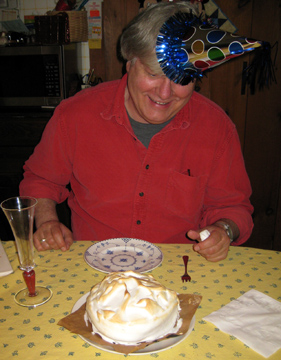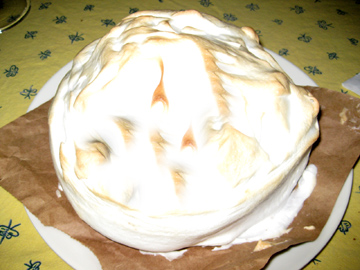
The Birthday Boy surveys his dessert.
My friend Peter Beck recently asked me to make Baked Alaska for his birthday. I was thrilled.
Like Cherries Jubilee or Bananas Foster, Baked Alaska is a showy dessert associated with “fancy” 20th century restaurants.
I pictured myself whipping it up casually in a little hostess apron, looking like Barbara Stanwyck and throwing my dinner guests into paroxysms of joy.
By the time I was finished putting all the pieces together I was a little too messy (and a little too me) to resemble Miss Stanwyck. My guests were pretty joyful, however.
A Little History
For readers unfamiliar with Baked Alaska, here is a bit of history. Caveat lector: I found this information on the internet. Some of it comes from Dartmouth College, however, which ought to be a reputable source.
Cooks of many nationalities (including the Chinese, who probably invented ice cream, and the cook in Thomas Jefferson’s kitchen) experimented with insulating ice cream with pastry and then baking it.
It was apparently the American-born chemist Benjamin Thompson who originated the exact formula for Baked Alaska in 1804. Fiercely loyal to the British in the Revolutionary War (he spied for them!), Thompson spent the rest of his life in Europe. He was named a count of the Holy Roman Empire by the elector of Bavaria for his social reform work there. Thompson chose the title Count Rumford because of his fondness for the town of Concord, New Hampshire, originally known as Rumford.
Count Rumford is best known for creating the kitchen range (known as the Rumford Range), which revolutionized cooking by giving home and restaurant cooks an alternative to hard-to-control and wasteful open fires.
In 1804 while experimenting with the insulating power of egg whites he invented what we call Baked Alaska (he called it omelette surprise)–cake topped by ice cream and meringue browned in the oven. The name Baked Alaska came later, many say from Chef Charles Ranhofer at Delmonico’s Restaurant in New York in honor of the 1867 purchase of the Alaska territory.
In his cookbook The Epicurean Ranhofer himself called the dish Alaska, Florida to celebrate its juxtaposition of hot and cold. It was first called Baked Alaska in print by my beloved Fannie Farmer.
A Touch of Rhubarb
With rhubarb on my mind these days I decided that Peter’s Baked Alaska would be no ordinary Alaska but a Baked Hawley, featuring one of my hometown’s most copious crops.
I called Gary Schafer and Barbara Fingold, who own Bart’s and Snow’s Ice Cream in Greenfield, Massachusetts. I figured if anyone could tell me how to make rhubarb ice cream it would be they. Their ice cream is always delicious and tastes homemade.
Barbara and Gary suggested that I wait until the very end of the freezing process to add the rhubarb so its liquid didn’t interfere with the consistency of my ice cream.
Of course, you don’t HAVE to use rhubarb ice cream. You don’t even have to use homemade ice cream. Many Baked Alaska recipes ensure super insulation of the ice cream by refreezing it, along with the cake below, for several hours before putting the meringue on top and baking the dish. If you want to try that method, you’ll be better off with commercial ice cream since homemade ice cream is best eaten fresh.
You may also vary this recipe. It can easily be made bigger or given a change of flavors. A brownie base with peppermint stick ice cream could be Baked Noel. Peach ice cream could be Baked Georgia. Apple Cake in autumn could be Baked Back to School (Baked Teacher just doesn’t sound friendly). And so on.
We all loved the rhubarb version, however—and I plan to make it (and the rhubarb ice cream it used) again.
I know this seems like a VERY long recipe. It’s not hard, however; it just has quite a few steps.

The Long But Not Hard Recipe
Ingredients:
for the rhubarb ice cream:
2 cups finely chopped rhubarb
1/4 cup plus 2 tablespoons sugar (for rhubarb)
1 pinch salt (for rhubarb)
1 tablespoon lemon juice
3/4 cup milk
2 egg yolks (save the whites for the meringue!)
1/3 cup sugar (for custard)
3/4 cup heavy cream
1 teaspoon vanilla
1 pinch salt (for custard)
for the cake:
1/4 cup (1/2 stick) sweet butter at room temperature
1/2 cup sugar
1 egg, separated
1 teaspoon baking powder
1 pinch salt
3/4 cup flour
1/4 cup milk
1/2 teaspoon vanilla
for the meringue:
2 egg whites
1 pinch cream of tartar
1/4 cup sugar
Instructions:
It’s easiest to begin this recipe the day before you want to make the final product: the rhubarb and ice-cream custard will need time to cool. (So will the cake, although it will need to cool for less time so you may make it a couple of hours before you need it if you like.)
First, make the rhubarb puree. Combine the rhubarb, its sugar, its salt, and the lemon juice in a small non-reactive saucepan. Let them sit for a few hours until the rhubarb juices up.
When it has juiced up, stir the mixture and bring it to a boil. Simmer it, stirring frequently, until the rhubarb is soft, and most (but not all) of the liquid has boiled off. Set it aside to cool; then refrigerate it until you need to add it to the ice cream.
Next, make the ice-cream custard. In a small-to-medium saucepan, heat the milk until it steams but does not boil. Meanwhile, in a separate bowl whisk together the egg yolks and sugar until they thicken and turn a light yellow (about 4 minutes). As noted above, the egg whites should be kept—in the refrigerator—until the next day for the meringue.
Whisk a little of the hot milk into the sweet egg yolks; then whisk a little more. Repeat this process; then whisk the egg yolk mixture into the hot milk. Heat over medium heat, whisking constantly, until the custard begins to thicken but does not boil (about 2 to 3 minutes on my gas stove).
Strain the custard into a heatproof bowl. Cool it to room temperature; then refrigerate it until it is cool (several hours or preferably overnight). Just before making the ice cream, you will whisk in the cream, vanilla, and salt.
The next day (or later that same day) make the cake. Preheat the oven to 350 degrees, and grease and flour a small cake pan. (I used my 7-inch springform pan.)
Cream the butter, and beat in the sugar until fluffy. Beat in the egg yolk, reserving the white. Stir in the baking powder and salt. Gently add the flour and milk alternately, beginning and ending with the flour.
In a clean bowl with a clean beater, whip the egg white until it forms stiff (but not dry) peaks. Fold it into the cake batter, and gently spoon the batter into the prepared pan. Bake until a toothpick inserted into the center of the cake comes out clean. (Using my gas oven and my springform pan this took about 30 minutes, but it may vary.)
Let the cake rest for 10 minutes before removing it from the pan. Let it cool.
About 1/2 hour before you are ready to make the Baked Hawley, preheat the oven to 450 degrees, and get out the custard. Add the cream, vanilla, and salt to the custard, and pour it into a 1-quart electric ice-cream maker. Start the ice-cream maker. Take the egg whites out of the refrigerator so they can come to room temperature.
When the ice cream is done, add the rhubarb puree. Let it mix in for a minute or two more. Try to make your ice cream as hard as you can but still removable from the ice-cream maker.
Rinse a wooden board on both sides with cold water, and shake it dry. Cut out a piece of brown paper (I used a grocery bag) large enough to hold the cake with a bit of extra room. Place it on the wooden board while you prepare the meringue.
Using an electric mixer beat the egg whites and cream of tartar until they begin to stiffen. Slowly add the sugar, and continue beating until the whites form stiff peaks. Set aside for just a minute.
Quickly place most of the ice cream onto the top of the cake (you will have a little extra to eat just as ice cream). Leave at least an inch of cake around the top edge so that the ice cream doesn’t slide down to the sides. If your ice cream is stiff enough try to pile it up in the middle to make an igloo shape. (Mine was more of a pillbox hat!)
Using a spatula spread the meringue on top of and around the ice cream and cake, making sure no cake or ice cream is visible.
Quickly pop the wooden board into the oven, and leave it there just until the meringue browns lightly, for about 4 to 5 minutes. Remove it from the oven, and serve the Baked Hawley at once.
Serves 4 to 6 rhubarb fans.